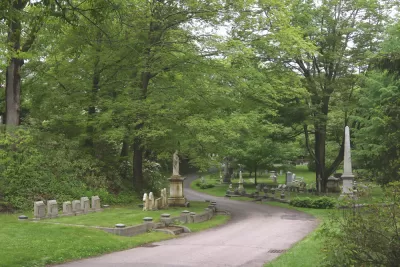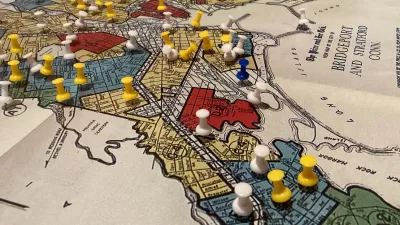Tracing the story of the American suburban form.

An article by Emma Newcombe in Governing describes the history of the American garden cemetery, starting with the Mount Auburn Cemetery outside of Boston, built in 1831 as the first of the sprawling rural cemeteries popular in the late 19th century.
As Newcombe explains, the early 1800s saw an increase in the sentimentality of Americans toward death and memorializing loved ones with pleasant, art-filled gardens, coupled with public health concerns about increasingly crowded urban burial grounds. Mount Auburn became a popular recreational site, with close to 60,000 visitors stopping in annually, and “By 1865, the United States had over 70 similarly landscaped cemeteries on the outskirts of cities, including Laurel Hill in Philadelphia, Green-Wood in Brooklyn and Mountain View in Oakland.”
The movement inspired a greater desire for urban parks and green spaces, with the New York state legislature setting aside 700 acres in New York City in 1853 that would become Central Park. Then, as the popularity of garden cemeteries and urban parks grew, developers started building America’s first planned suburbs, using similar principles to design new residential communities.
According to Newcombe, by the 20th century, rural cemeteries fell out of favor as maintenance costs grew and the Victorian fascination with death waned. Meanwhile, suburbs also became “far less picturesque and romantic than their 19th-century counterparts” as developers focused on cutting costs and building quickly, choosing “uniformity over picturesque asymmetry.”
FULL STORY: From Cemeteries to Suburbs: How a Romantic Movement Reshaped America

Maui's Vacation Rental Debate Turns Ugly
Verbal attacks, misinformation campaigns and fistfights plague a high-stakes debate to convert thousands of vacation rentals into long-term housing.

Planetizen Federal Action Tracker
A weekly monitor of how Trump’s orders and actions are impacting planners and planning in America.

San Francisco Suspends Traffic Calming Amidst Record Deaths
Citing “a challenging fiscal landscape,” the city will cease the program on the heels of 42 traffic deaths, including 24 pedestrians.

Adaptive Reuse Will Create Housing in a Suburban Texas Strip Mall
A developer is reimagining a strip mall property as a mixed-use complex with housing and retail.

Study: Anti-Homelessness Laws Don’t Work
Research shows that punitive measures that criminalized unhoused people don’t help reduce homelessness.

In U.S., Urban Gondolas Face Uphill Battle
Cities in Latin America and Europe have embraced aerial transitways — AKA gondolas — as sustainable, convenient urban transport, especially in tricky geographies. American cities have yet to catch up.
Urban Design for Planners 1: Software Tools
This six-course series explores essential urban design concepts using open source software and equips planners with the tools they need to participate fully in the urban design process.
Planning for Universal Design
Learn the tools for implementing Universal Design in planning regulations.
Heyer Gruel & Associates PA
JM Goldson LLC
Custer County Colorado
City of Camden Redevelopment Agency
City of Astoria
Transportation Research & Education Center (TREC) at Portland State University
Jefferson Parish Government
Camden Redevelopment Agency
City of Claremont




























